 |
|
|
The wildfires of 2011 brought much devastation to Bastrop and other areas of Texas. Although fire is a natural part of nature's processes, we can help accelerate the healing of natural ecosystems by planting appropriate native seeds and larger native plants. With this in mind, Healing Hands, Healing Lands, with the help of sponsoring organizations and Native American Seed, has developed seed ball kits of native flower, grass, and other plant seeds appropriate for fire-stricken Central Texas areas. These seed ball kits have been distributed to schools to encourage youth environmental stewardship and to teach about the importance of native plants. |
|
|
| For the Bastrop area (Bastrop Lost Pines, Oakwoods Prairie, Pineywoods and Gulf Coast Prairie eco-regions), for example, the seed ball kits contain dry red art clay, sifted dry compost with fungi and soil microbes, and a special blend of seeds containing pioneer species such as Green Sprangletop, as well as many other native plant seeds. The complete Bastrop list includes: Little Bluestem, American Aloe, Balsamscale, Big Bluestem, Black-Eyed Susan, Broomsedge Bluestem, Brownseed Paspalum, Bushy Bluestem, Cane Bluestem, Clasping Coneflower, Common Sunflower, Croton, Cutleaf Daisy, Epazote, Florida Paspalum, Gayfeather, Giant Coneflower, Green Sprangletop, Gumweed, Hairawn Muhlygrass, Horned Beaksedge, Illinois Bundleflower, Indian Blanket, Indiangrass, Knotroot Bristlegrass, Lanceleaf Coreopsis, Lemon Mint, Longspike Tridens, Marsh Elder, Native Sedge, Partridge Pea, Plains Coreopsis, Prairie Agalinis, Prairie Verbena, Prairie Wildrye, Purple Prairie Clover, Purpletop, Ragweed Annual, Rattlesnake Master, Red Lovegrass, Rough Buttonweed, Sand Dropseed, Sand Lovegrass, Sideoats Grama, Slim Tridens, Smartweed, Splitbeard Bluestem, Sumpweed, Switchgrass, Tall Dropseed, Tall Goldenrod, Texas Bluebonnet, Texas Cupgrass, Texas Yellow Star, Three-Awn, Vervain. |
|
| Making the Seed Balls
The following instructions show how to make the seed balls using the kits.
|
|
| In addition to your seed ball kit, you will need: hand garden trowel, plastic dishpan or similar shallow mixing container, measuring cup to measure 3 cups of water (approximately), plastic sheet or newspaper to cover the work area, 2 trays/cookie sheets/shallow cardboard boxes (with raised edges) for drying seed balls, a container of water for hand washing, paper towels, and space or a rack for drying. |
|
| 1. This step is best done by an adult. You might want to wear gloves, which are included in the kit. Carefully empty seed ball kit contents into the mixing container; avoid dust dispersal. Use a garden trowel to carefully stir the dry mixture until well blended. |
|
|
|
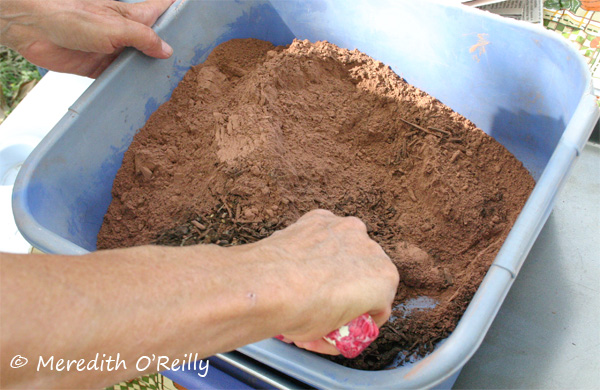 |
|
| 2. Add water in small increments as you stir; it is important to keep the mixture on the dry side, so don't pour in too much water at once. Use a trowel at first, but after a little while it will be easier to switched to gloved hands to incorporate the water into the mixture until it holds together. Remember, avoid "sloppy wet." |
|
|
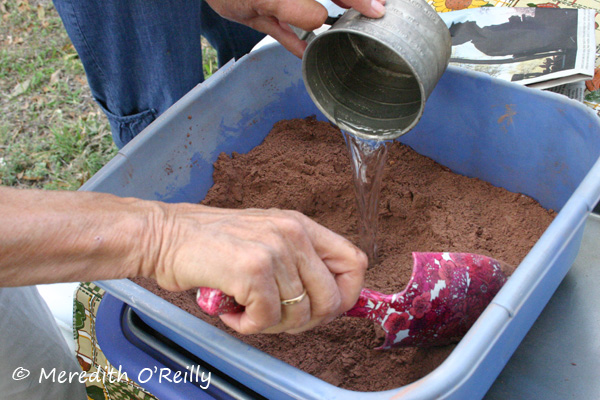 |
|
|
|
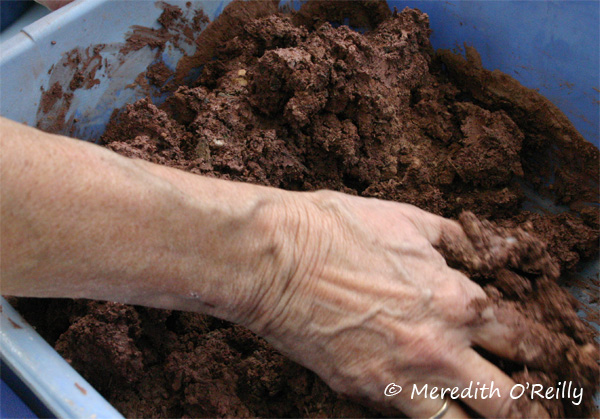 |
|
| 3. At this point, an adult volunteer can pinch off small wads for the youth helpers to roll into balls (see kit sample). Alternatively, you can continue with the following steps to help make the quantity manageable and the seed ball sizes consistent.
Divide the mixture into 4 or 5 large sections (in the image below, the other two balls were already completed).
|
|
|
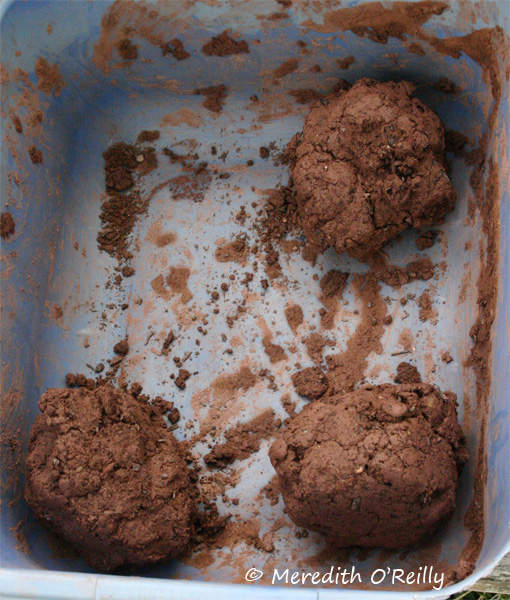 |
|
|
| 4. Cut the ball into smaller chunks, then roll these into basic hot-dog type shapes. Use a dull knife to slice small bits that can be rolled into the size of marbles, roughly the diameter of a penny (your kit has sample seed balls to show the finished size). |
|
|
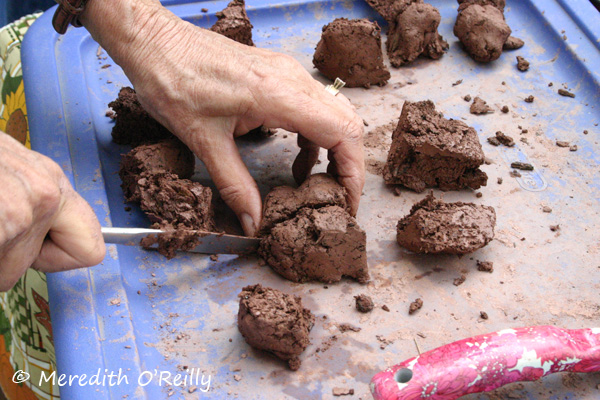 |
|
|
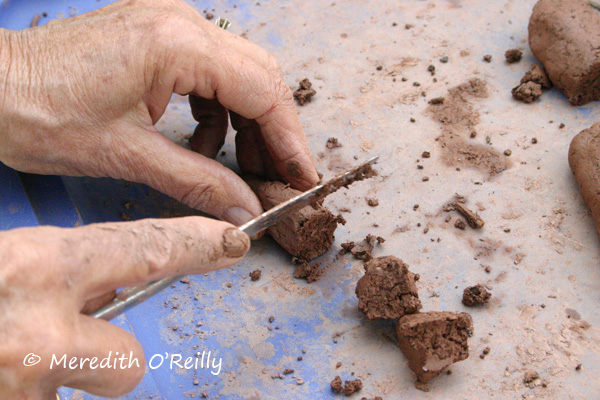 |
|
| 5. Have youth helpers roll each seed ball to marble size (or the diameter of a penny). Set the balls on a cookie sheet or tray to let dry for at least 2-3 days. Each kit should make 330-350 balls. |
|
|
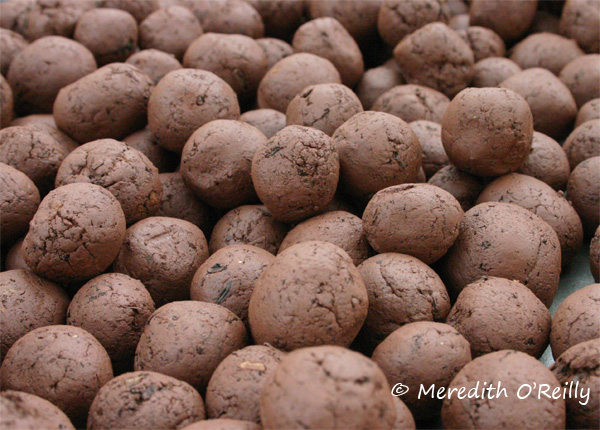 |
|
|
| Once the seed balls are completely dry, the seed balls should go carefully back into the original box. You can separate the layers with newspaper. Be gentle when moving the boxes around. Let us know when your seed balls are ready, and we'll pick them up and deliver them to the recipient areas. |
|
|
Thank you for helping restore the natural ecosystems of our fire-stricken areas! |
|
|
|
|
|
|
|
|
|
|
|
|
|